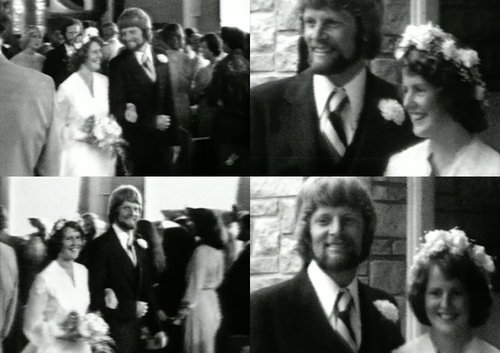
By Jamie Lean
After Andrew contacted us, we discussed the tape with him and invited him to bring the tape in and deposit it with the Archive. We were particularly interested in this because it was a wedding from the late 1970s that included interior shots and sound. Ngā Taonga has an impressive collection of home movies, including a great number of weddings dating from the 1930s to the early 1970s, but the drop-off in the use of film cameras for personal use meant that we had a gap in the ongoing record of domestic events like weddings. This is still true today.
Andrew consented to become a depositor and dropped into the Archive, presenting us with his wedding video. He told us that there was a second tape at home. I looked at the tape and realised that it would not be a straight-forward process. The tape was a Sanyo VT20C, belonging to a long-forgotten video format family known as V-Cord. This was Sanyo’s attempt to compete with the VHS and Beta consumer videotape formats, and unfortunately we had no equipment that could play it. I asked Andrew if they had the original camera or a videotape deck that could play the tape. He said that they had borrowed the camera from the local rugby club so had not seen the tape for 25 years. I asked him to be patient and told him that we would look at a number of options.
I then proceeded to enquire with other institutions and museums around the country as to whether they had any working examples of a Sanyo V-Cord machine that would take the VT version of the tapes. The answer, eventually, was “no.” I widened the search to include Australia – asking archival institutions and commercial providers whether they could help. After a few months with no result I contacted the American umbrella organisation for archives, AMIA, and a couple of likely institutions such as the San Francisco based Bay Area Video Coalition (BAVC). There was a moment of hope when BAVC responded that they did have a couple of working machines but we quickly realised that they were in the American broadcast format, NTSC, while our tapes used the PAL system. Enquiries to Sanyo in Japan also came to nothing.
I had to inform Andrew and Janice that I had not been able to transfer their tape, but reassured them that the Archive would keep trying. In 2009 Andrew rang again to see if there had been any progress, and after finding that there had been none suggested that he take the tape home. I convinced him that the Archive wouldn’t give up, and the tape would be better off under our care, in a climate-controlled vault, while we continued to look for a solution.
In 2014 a video transfer provider, Utel – based in Adelaide, Australia – sent an email promoting its newly-acquired capabilities with new old machines being purchased and rehabilitated, including major broadcast formats. Way down the list I was excited to see a Sanyo VT-Cord machine listed! With the help of Preservation Manager Louise McCrone, I arranged for Andrew and Janice’s tapes to be sent to Australia. This is always a risk that is not taken lightly by the Archive – sending unique material anywhere is a risk– but we had established a comprehensive system prior to shipment, and the tapes were sent off in October. Just before Christmas they were returned, and it was thrilling to be able to give the delighted Janice and Andrew several DVD copies of their wedding 36 years after it had taken place and 10 years after they had come to the Archive for help.
Hero image: Scenes from Andrew and Janice’s wedding tape.